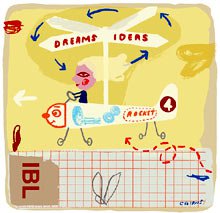Listen Up: The Kids Have Something to Say
Give children a voice in their own education.

Every day, we ask children to devote themselves to an education system designed and operated by others. They aren't asked what they want to learn or how they should learn it. Even the most mundane aspects of their school days are prescribed -- without their input. How can we expect these kids to feel any obligation or responsibility to comply with the system if their voices aren't heard?
If children were adults, we would be fighting to free them from this totalitarian state and restore their human rights. As a seven-year-old friend of mine put it, "The adults should not just give something to kids and say, 'Do it.' We should work together."
He's right. When children find their own ideas listened to, accepted, and put into action, they begin to see themselves as leaders and, consequently, they act like leaders. This concept, called interest-based learning, is brilliantly simple: Give children choices and power in determining the shape of their education, and in the process you will teach invaluable life skills.
IBL is dedicated to the idea that, while meeting the goals of the curriculum, children should guide and direct their own learning by partnering with their teachers and parents to ensure that their interests are reflected in it. When these goals are related to their own passions, children enjoy learning and become motivated to excel. And when children design learning environments based on these interests, they are more willing to be responsible for the results and for themselves.
Students running the show? How can that make for effective learning? In IBL, teachers collaborate with children to custom design a curriculum in which reading materials, writing topics, science projects, spelling lessons, and math can all be related to student-chosen activities. State-mandated curriculum skills are constantly identified and reinforced in collaborative project work stemming from student-led discussions.
There is structure in IBL, but it's not traditional structure. Children don't make decisions alone, but they do develop consensus through teamwork and project development. IBL students must come to an agreement about how they will accomplish their goals and learn the skills necessary to pass required exams. The structure is flexible, yet it requires the children to set goals and time frames for themselves while continuously identifying their accomplishments.
IBL teachers, like any others, are still responsible for fulfilling curriculum requirements and ensuring that students are prepared for exams. Meanwhile, students employ the skills, knowledge, and information achieved through carrying out their projects to pass the tests, instead of applying their learning to completing unrelated worksheets.
But IBL children are not just learning for the sake of passing exams; they learn because they are inspired to do so. Their curiosity and interests are awakened, supported, and developed. In the IBL learning environment, we create a respectful, orderly, cooperative, and trusting classroom. The students create the rules to which they will adhere in order to support their group and the class as a whole.
For example, in order to teach kindergartners about problem solving and working together, I purposely provided them with few classroom materials, and the students began to argue with one another over the scant supplies. I listed their complaints, and they asked me what they should do. I kept asking them to identify the problem. They finally agreed that the real problem was, "We don't know how to share." Eventually, I asked them to identify the solution. The kindergartners decided to make a graph of materials each student used and how much time they spent using them and then determine the length of time each student would have to use certain materials. Through this experience, the kids discovered how math and graphs could be used to solve real-world problems.
We use the words "responsible" and "accountable" with schoolchildren every day, but how can we expect them to understand what those words mean if they have never been part of the process by which they are held responsible and accountable? Through IBL, children learn to demonstrate these qualities in the choices they make every day through problem solving and group participation. If we want a world where we value, appreciate, and cherish every child, we must include each child in the crucial discussions about how they are educated.